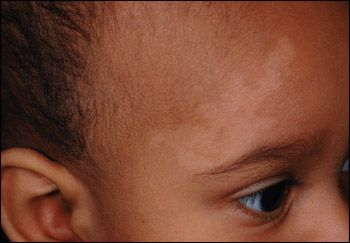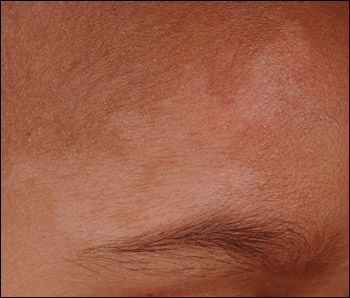What About This Light-Colored Patch Over an Infant’s Brow Rules Out Vitiligo?
The mother of this 11-month-old Somalian girl expressed concern about a light-colored patch over her daughter’s right brow. She was worried that the infant had vitiligo.

Case:
The mother of this 11-month-old Somalian girl expressed concern about a light-colored patch over her daughter's right brow. She was worried that the infant had vitiligo.
What finding will quickly put the mother's fears to rest-and help establish the real diagnosis?
Hypopigmentation rules out vitiligo, which is characterized by a complete lack of pigment.

This child's lesion is nevus depigmentosus, sometimes referred to as nevus achromicus. Nevus depigmentosus is usually present at birth as a solitary hypopigmented patch a few centimeters in size, with irregular but well-demarcated borders. Nevus depigmentosus has no medical significance and does not require any investigation.
Before diagnosing nevus depigmentosus in a child with a lesion that is lighter in color than the surrounding skin, it is important to rule out other, more serious and more rare conditions. In contrast to the lesions of vitiligo, which contain no skin pigment, the patches of nevus depigmentosus are hypopigmented compared with normal skin.
In my experience, however, the lesion that most often must be differentiated from nevus depigmentosus is nevus anemicus. A simple diagnostic test can identify a lesion as nevus anemicus: with one finger, stroke across the lesion and onto normal skin; if the stroke produces a red flare in the normal skin but not in the lesion, the lesion is nevus anemicus. The lack of color change in the lesion is explained by an increased sensitivity to catecholamines in the blood vessels of the nevus, which inhibits vasodilation. However, the pigment cells in nevus anemicus are normal.
If a patient's hypopigmentation occurs in whorls and streaks, it is prudent to consider the possibility of hypomelanosis of Ito; in one-third of affected children, this condition is associated with significant developmental abnormalities.
Recognize & Refer: Hemangiomas in pediatrics
July 17th 2019Contemporary Pediatrics sits down exclusively with Sheila Fallon Friedlander, MD, a professor dermatology and pediatrics, to discuss the one key condition for which she believes community pediatricians should be especially aware-hemangiomas.